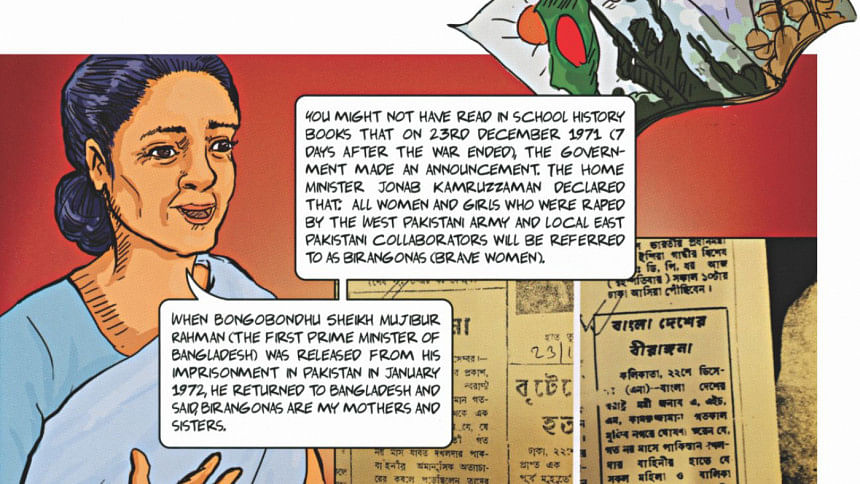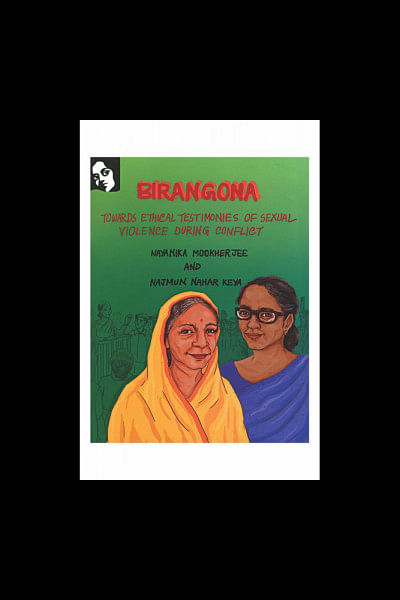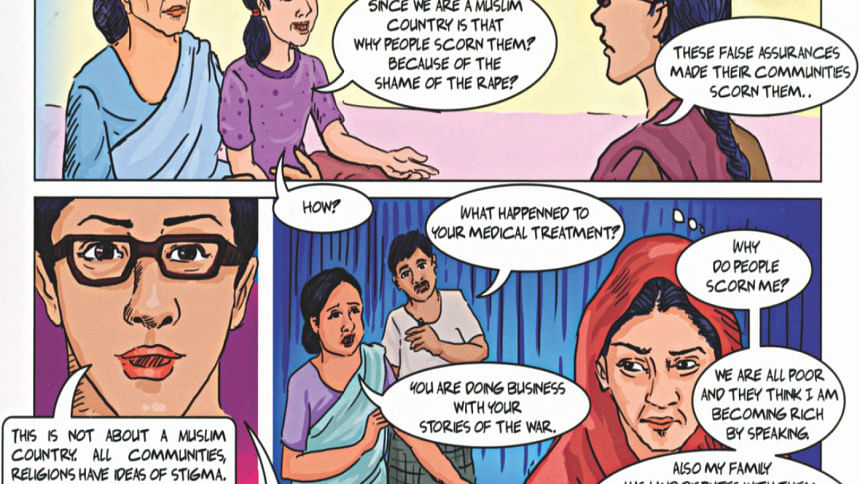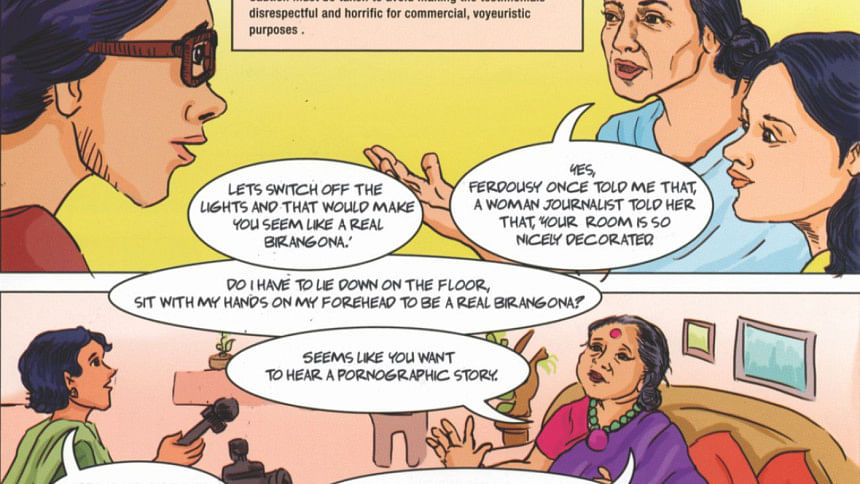A graphic novel tackles the ethics of interviewing birangonas

The book opens to a dark, ominous scene. An armed man in a soldier's uniform chases a woman through an open field, her saree unfoiling, smoke billowing from hedges and houses in the horizon. “I will give my life but not my honour,” the woman says clinging to a pole, as the soldier's heavy shoes thud on the ground. In the next image, the stomp becomes a knock on the door, and we realise that she has been having these flashbacks in her sleep. The dark scene cuts drastically to a lighter, brighter one as the woman is woken up by her granddaughter. 12-year-old Labony wants to talk to her grandmother about her memories of the Liberation War for a school project. “I dreamt of the war. I remembered lots of horrific things and many of my friends,” the grandmother says, recalling her nightmare. “Maybe by telling me you might feel a bit better?” Laboni asks.

Over the years, all the research and discussion on the Liberation War—while necessary— has inadvertently dehumanised our public memory of it. We quote figures of those tortured and killed (such as the 200,000 women raped), but we forget that these are more than just statistics for those who lived through them; these are memories of trauma, of loss of livelihood and loved ones. Compiling information on the war by sensationalising it, by reducing its survivors to mere stores of data, and by interviewing them through unethical and inconsiderate methods renders the entire project of war remembrance pointless. Worse, it adds to the sufferance of the survivors. Professor Nayanika Mookherjee's Birangona: Towards Ethical Testimonies of Sexual Violence during Conflict (2019) tries to tackle these issues with respect to “birangonas”, the women who were raped by the Pakistani army and their collaborators during the war. That first scene in the book captures the essence of the project. It addresses how, while talking to survivors of the war is crucial to shaping our knowledge of it, it's just as crucial to remember that these public memories are in fact deeply personal for those who lived through them, that we need to allow the survivors their agency and be sensitive as they recollect their experiences. The book attempts this by weaving historical accounts into a family discussion, into the uniquely intimate space in which a Nanu tells her grandchild stories.
The book is illustrated by freelance artist Najmunnahar Keya and prepared in collaboration with Research Initiatives Bangladesh, published both in English and Bengali by NOKTA (which specialises in books of visual art). The use of illustrations and simple language is meant to share Professor Mookherjee's research from her book The Spectral Wound: Sexual Violence, Public Memories and the Bangladesh War of 1971 (2015) in a form that is easy to understand, not only for journalists and researchers, but also for general readers including school students. As Professor Mookherjee shared at the book launch held at the CIRDAP Auditorium on April 7, the interview guidelines described in the book were suggested personally by victims of wartime sexual violence and fine-tuned with feedback from journalists, academics, and activists collected during workshops between 2016 and 2019.

The story unfolds as the grandmother explains to Labony how Home Minister Kamruzzaman, on December 23, 1971, announced that the women raped during the war would officially be known as birangonas—the “brave women”. She continues the narration, touching upon the women's experiences during and after the war—how they were physically and psychologically affected and shunned socially, but how some of them had also found support among their families and managed to build careers. The crux of the conversation appears when Labony's mother Hena recounts her experience interviewing some of these women for an oral history project in the 1990s. As Hena launches into her suggested list of interview guidelines, the illustrations cut to scenes of interaction between the interviewers and the survivors in their natural settings: stories exchanged while swimming together in a pond, while applying oil to each other's hair, or posing for pictures in mustard fields. While fictionalised for the book, these scenes all derive from real life incidents that occurred while Professor Mookherjee spent time with survivors for months on end.
The point, as the professor explained at the book launch, was to delve beyond the literary and historical figure of the birangona. “I am not only a birangona, I am your Nanu, I worked for many years in my government job, brought up my daughter Hena, your mother,” the grandmother explains once Labony realises that her Nani is a birangona too. Shundori Khatun, the daughter of a birangona that Professor Mookherjee spent time with, shared a similar sentiment at the launch. One on hand, their struggles didn't end with the war. As a result of being recognised as a birangona, her mother and their family had been ostracised over the years, physically abused and evicted from homes. But their identity, Shundori stresses, comprise more than just the sum of their tragic experiences—it is also made up of their daily lives, their practices and individual outlooks on the issue of the birangona, and the bravery they have shown over the years. Birangona stresses how these identities can be captured in all their complexity only if the research on them is carried out responsibly. This includes sufficient secondary research, steering clear of sensationalism, protecting the survivors' interest and right to privacy, and investing enough time and effort in getting to know their stories.

In planning for the book, however, one of the trickiest challenges lay in choosing appropriate representation. The term 'birangona' had originally been adapted to accord respect to women raped during the war. But over the years, the title has generated the opposite effect, with the women becoming socially marginalised and being recognised only as victims of wartime violence. Some of the survivors Professor Mookherjee interviewed accept the title of birangona, while many others feel strongly that they should be called muktijoddha (freedom fighters) instead. Keeping these debates in mind, Professor Mookherjee decided to name the book Birangona as a nod to its historical trajectory, especially given that Bangladesh is the only country to not maintain silence about the sexual violence that occurred during wartime. The desired effect of the book would be to bring the agency, the respect and the nuance, back to the women titled thus.
It achieves these results insofar as getting the conversation started. With as sensitive a topic as the ethics of talking to victims of sexual assault—and that too during wartime—having a simple visual primer helps. While researchers working on an extensive project might ideally have the time to go through Professor Mookherjee's more detailed work in the Spectral Wound, the simple text and visual aid in this slim edition will likely be helpful for journalists, activists and other researchers on the go. And these instructions need not apply only when interviewing birangonas; it can be used when the research involves speaking to people on any other similarly sensitive matter.
The book claims to be a graphic “novel”, since it fictionalises historical incidents. It isn't really a novel in the traditional sense, though. The fiction portion of it resides mainly in the frame of the narrative—the part where Labony learns about birangonas from her mother and grandmother—and the representation of the birangona's history through the grandmother's memories. But the reader is made constantly aware that it isn't meant to be read simply as fiction, not at least for the usual purposes of leisure and entertainment. Unlike most other historical fiction or nonfiction books on history, Birangona makes its desired effect on the reader apparent. It's meant to inform and instruct, as is made plain from the title, the didactic tone of the text, and the headings labelling the stage of testimony in each illustration.
Because of these mixed elements, the downside is that it might confuse some readers—who exactly is it written for? Is it a “novel” for general readers, or a textbook of sorts for researchers and journalists?
The plus side is that it can be both. The book does a remarkable job of showing how the story of a birangona can be told appropriately, thereby demonstrating the very methods that it recommends. This places it at an interesting crossroads between genres—"graphic novel”, historical account, and research manual—no doubt an interesting specimen of what a book can be and hope to accomplish.
Free downloads of the book will be available at their website: ethical-testimonies-svc.org.uk.





Comments